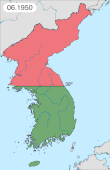Hadong Ambush
The fight ended in a North Korean victory following a successful ambush of US forces which resulted in heavy American casualties.
Unprepared for combat, the UNC forces walked into an ambush in which most of the battalion's command staff was killed in the pass, leaving lower-ranking soldiers to mount a disorganized defence against North Korean troops occupying prepared positions on higher ground.
Destroyed after its first engagement, the 3rd Battalion, 29th Infantry Regiment was disbanded and merged with other units as the North Korean forces advanced through the pass and attacked US positions to the east.
[6] The 24th Infantry Division made a final stand in the Battle of Taejon, being almost completely destroyed but delaying North Korean forces from advancing until July 20.
[13] Instead of being given time to train and prepare to enter the front lines, the battalions were immediately sent to the regiment's sector at Chinju.
[12][15][16] American planners believed that the Hadong area was under attack from elements of the KPA 4th Division, having just received replacements following its victory at Taejon.
[17] Immediately after arrival, the commanding officer of the 19th Infantry Regiment, Colonel Ned D. Moore, ordered the 3rd Battalion, 29th Infantry to move out and seize the Hadong pass, a road junction 35 miles (56 km) southwest of Chinju, where about 500 North Korean soldiers were reported to be moving.
[1][15] Eighth Army had also received reports that the KPA had been fighting South Korean police who were resisting in the village of Hadong, 1 mile (1.6 km) west of the pass.
The move was part of a larger coordinated operation by the 6th Division to take Chinju, and then Masan, in hopes of flanking the UN lines at their vulnerable southern limit.
[17] Thinking the UN units were disorganized and suffering low morale, KPA 6th Division commander General Pang Ho San ordered his forces to aggressively advance to Chinju as quickly as possible.
[11] Shortly before dawn, the troops encountered a truck of 15 South Korean militia who claimed they were the remains of a 400-man unit that had been wiped out by KPA forces in the area.
L Company then rushed the pass and dug in at 09:30, waiting for a scheduled airstrike on the village of Hadong 1 mile (1.6 km) to the west at 09:45.
[23] The battalion's command group, including Mott, Chae and most of the senior officers, approached the pass as L Company took cover on the left side of the road.
As they approached the pass, a company of KPA soldiers was spotted up the road, part of a scouting party looking to probe further east.
[16] The North Koreans immediately ducked for cover in the ditches on the side of the road, and L Company opened fire on them.
[16] Mortar fire knocked out many parked vehicles, including the radio jeep of a US Air Force tactical air-control party which was to direct airstrikes.
Men of I Company were forced to withdraw through rice paddies south of the pass, being strafed by mortar and machine gun fire in the process.
[1] The largest group of 97 survivors moved 5 miles (8.0 km) south to the small port of Noryangjin where a fishing vessel carried them out to a Republic of Korea Navy patrol boat.
[33] This left the southern entries to Pusan open, but the KPA 6th Division was unable to exploit it due to its extended supply line.
[28] The 6th Division eventually advanced further east, attempting to capture the city of Masan, but newly reorganized troops of the US Army repulsed them and inflicted heavy casualties on them less than a week later during the Battle of the Notch.




Chinese and
Soviet forces
• South Korean, U.S.,
Commonwealth
and United Nations
forces